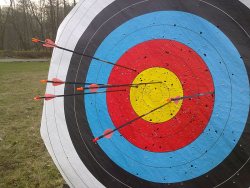 For me, editing was the worst part of writing, which is why I never did it.
For me, editing was the worst part of writing, which is why I never did it.
In an attempt to turn editing into a more manageable process, I have combined two of my favorite hobbies into one theory, which I call “Target Editing.”
I compare editing to archery.
Archery is a wonderful sport. It takes very little skill to get mediocre at it, and your output is directly influenced by the amount of practice you put in. Sound familiar?
1. White Ring
Anyone can finish a first-draft manuscript. I consider that goal the first ring on the target, the white one, worth one point.
As soon as I have my manuscript finished, I’m on the target. That’s already halfway to the goal, isn’t it?
2. Black Ring
The black ring is next. It’s not a bad goal, but a little harder to hit.
This is the stage where you give your WHOLE manuscript a read and take notes on plot consistency, character consistency, and overall flow. We want to make sure all the elements are there, consistent, and make sense.
Something doesn’t make sense? Make a note and go back to the outline to either cut it or change it, making certain everything lines up, all loose ends are tied up, and the story itself is solid.
Notice how I haven’t mentioned spelling or grammar?
I think people waste time tightening up dialogue or fixing grammar, tense, or POV slips, when they should be looking past those for now because we’re only in the black ring.
If you take time to fix nit-picky things here, you’ll never get to the bullseye. Trust me, I did it for two years!
3. Blue Ring
Oh blue ring, you’re so close to the red, but only worth three points. Don’t let your aim be lucky, go for consistency and make your time count!
The next step is taking notes on scenes. Not chapters, but scenes.
A scene where one character gets caught in a lie, a character is wounded and almost dies, a board meeting or war council, heck, even a conversation over breakfast.
Each scene in the novel must do one of three things: It must move the plot forward, it must help the reader get to know the character in a meaningful way, or it must pull the reader further into the world or story. I’m terribly guilty of keeping scenes because they amuse me (much to the frustration of my crit partners).
In the blue ring, I detail which scenes are strong (pulling the reader in, getting to know the characters AND furthering the plot) and which scenes are weak (hitting one or none of the goals). Once I have my list of weak scenes and strong scenes, I can look carefully at the best ones and emulate the reasoning behind why they were strong. That helps me determine what to apply to the weaker scenes, and which weaker scenes should be cut from the story.
4. Red Ring
The red ring is four points, and is closing in on the bullseye. The red ring is a hard one, directly proportionate to how much harder it is to get through the red ring on the target and into the yellow.
In editing, this is the stage where you go from beginning to end (after all those individual scenes have been strengthened) and give it a good once-over. I mean, the works. Grammar issues, misspellings, wordiness, flat descriptions, erroneous or inconsistent thoughts, feelings, actions or dialogue. Also, this is the point where I really look at chapter breaks, chapter lengths, tone consistencies, tense boo-boos, and POV balance/ consistency.
It’s really important to plan for this step and do it quickly (not sloppily, but within a few weeks so you don’t forget things). It’s at this point that you should ask other people to read the manuscript and offer advice. You’re making the final edits. A scene that might have been strong before can be fussed with to become stronger. Every description should be analyzed for impact and clarity, etc.
5. Yellow Ring – The Bullseye
The yellow ring is worth five points. It’s like hitting five of the white with one arrow. This ring is the big boy ring, no playing around.
For my archer friends who have to score a 120 just to increase their ranking, this is their only goal. As a writer hoping to submit my work, it has to be mine, too.
The yellow ring is the final pass. It’s catching every typo, every superfluous comma, and every little naggy thing such as, “I don’t like the word spirit, maybe you could change it to ghost.”
Before entering the yellow ring, the manuscript needs to be 90-95% of where you want it to be. It needs to already be tight, moving, interesting, and engaging. Do not enter the bullseye before you’re honestly ready, or you will only be discouraged and disappointed when it gets shot down time and again with every partial request. Yeah, I know this from personal experience too. Once you’ve done this last sweep, you can feel fully proud of your second-draft manuscript.
Hurry on then, write your query letter and send it out. What are you waiting for? It’s not going to get any better with more tampering. If you had reservations, you shouldn’t have left the red ring!
Making Progress, One Step at a Time
I’m not saying this process will work for everyone, but for me, it’s the absolute best way for me to work on editing my own manuscripts.
I spent two years treading water before I learned how to swim… scratch that, let’s draw a parallel with archery.
Hmm… I spent two years adjusting my stance, holding my arrows differently, and joking with the guys on the line rather than paying close attention to my aim. Yeah, that one is harder to understand than the swimming reference unless you’re an archer. You get the point.
You have to do this as a process. If you start making adjustments to everything all at once, you never hone in on that bullseye. You just spend a lot of time frustrated.
It finally sunk in for me, after two years of shooting archery, that formations are more important than hitting the bullseye. I was in shock to learn that my friend aims BELOW the target to hit the bullseye. I couldn’t believe it. So, I started doing a consistent stance, draw length and nocking technique, and low and behold… I got my first few-inch formation… in the hay bale. But it was a start. Once you can get a six-arrow formation spanning a few inches, you’re on your way to being able to move that formation and placing it anywhere on the target you want to.
Editing is the same way. Once you can train your mind to do each step efficiently, consistently, and thoroughly, you can suddenly edit whole manuscripts in a few months rather than years. It becomes less a dismal, dreaded chore and more an acknowledged, accepted part of the writing process. Best wishes!
Your Editing Process
Do you have a process for editing that works for you?
How long did it take to edit your first novel, and how much time do you spend now?


I do some nitpicky stuff early on like checking grammar, but that’s because I have Grammar OCD and it’ll distract me from the bigger stuff otherwise. 🙂 But then again I also do that while the work is in progress, so it’s not a big issue once the first draft is finished.
As for time…if you include the weeks I set the manuscript aside to come at it with fresh eyes, then it generally takes me about three months. That also includes two or three all-the-way-through passes. For the most part my editing attacks are the same as yours.
I have not written a full book yet, so I’ve not needed such an involved editing strategy. However, I do think about my play on words a lot when I write, and that is something I watch out for.
Excellent thoughts and pattern to get a story edited properly and well. It brings out points to check, such as characters AND scenes. Thanks for sharing it, I am copying this and saving it for a pattern – it’s extremely useful!
That’s excellent – but I think I lack the discipline to pull it off. That’s always been my problem which might explain why I’m not as successful as a writer as I wish I was.
That’s a great strategy. To be honest, I hate editing as well but only because by the time I’m finished several hundred pages I don’t want to wade back into them. I’m much better editing other people’s work.
@Stephanie I hear you on that! I would rather edit someone else’s work than my own and trade off that way.
I don’t usually give my manuscripts that many passes. Maybe that’s a bad thing? Who knows. Everyone’s different though. I do like the comparison to archery though. Writers always want their writing to hit a bull’s eye.
Where does professional editing fit in there? Somewhere around the center ring I would guess. My process of editing usually revolves around moaning a lot, the occasional tears (hey.. I’m a sensitive guy) and a lot of hair pulling.
@Frank P I’d think that a second draft is good enough to send to an agent. If they bite, they’ll send it to a professional editing process.
Yay! A method for editing with a clearly-defined end. I admit I have issues with tweaking and picking at my manuscripts before I get up the courage to send them out into the cold, cruel world. Thanks for the overview of your method here.
@Kimber You’re welcome. It took me a full year of fumbling around before I got to a process that worked for me. I understand it won’t work for everyone, but I wanted to encourage people to do a process rather than starting at chapter one and trying to make all changes simultaneously and wasting effort and time… and going crazy.
This is insanely helpful to me, who would turn that 5-ring bull’s eye into a kaleidoscopic cross-section of some ancient tree. Or… I add too many steps when I edit. The process has to end somewhere, and with clear-cut goals in each step, this might just work for me. Thanks!
@Melanie Glad to be of service and share some of my mistakes and victories.
I like how you have broken this down. For a new writer like myself, this post is very helpful, Blue Ring especially.
This was a really good read. -I’ve always been interested in writing a book, just haven’t progressed that much.
Thanks for the comments, everyone. I’d like to think I’m getting better at both simultaneously, by reminding myself to take my time and be conscious of my aim. 🙂 Best wishes.
I do love archery and I prefer editing to writing the first draft, I hadn’t thought of the two things as being similar, but reading your post I can see it now! Very interesting thank you!! 😀
VampWereZombie What an interesting, insightful view- thanks for sharing!
Good article.
For me, the best approach to editing is to let the manuscript sit for 2-3 weeks, and then approach it with a fresh set of eyes. I usually end up doing this several times until everything flows as I like, and then I pass it on to my beta readers.
Great article, thank you!